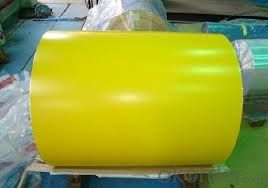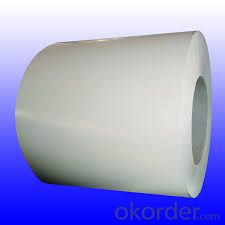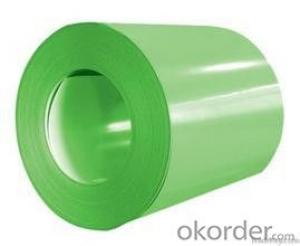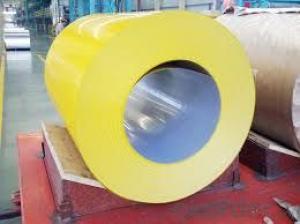Prepainted Galvanized rolled Steel Coil-DX51D
- Loading Port:
- Tianjin
- Payment Terms:
- TT OR LC
- Min Order Qty:
- 100 m.t.
- Supply Capability:
- 500000 m.t./month
OKorder Service Pledge
OKorder Financial Service
You Might Also Like
Description:
Prepainted Galvanized Steel usually refers to have substrateprocessed with surface processed and coated then(roller coated )or bonded organic thin film and baked, and it is able to be processed tofinal prodevtion .
PrepaintedGalvanized Steel qualified with excellent decorative ,formability ,corrosionresistance ,coating adhesion ,can keep for a long time as well as maintainfresh color .For color coated steel sheet can obtain good economicbenefit by steel belt wood ,efficient in construction and save energy ,preventpollution etc.Which is an ideal material;for manufacturing board.
Technical Data:
Yield Strength | (Mpa) 280-320 |
Tensile Strength | (Mpa) 340-390 |
Elongation | 20%-30% |
Reverse Impact | 9J |
T-bending | ≥2T |
Pencil Hardness | ≥2H |
Duration Of Salt Spray Test | 500 H |
Bending At 180 Degree | No crack, purling and fraction |
Applications:
It can be widely used in transportation, light industry, civil usage and farming. It is also the perfect building material in construction for making steel roofing,insulation panel, corrugate sheet, facade wall,shutters,T-bar and home appliance.
Packaging & Delivery:
The packing of coils consists of anti-damp paper, PVC film, hardboard paper, steel box, strapped with steel strips, fitted with locks and edge protectors and guarantees the optimal condition of the delivered goods. Each coil can be additionally fitted with wooden/steel skids(eye to the side) or wooden pallets(eye to the sky).
Images:


- Q:I bought a stainless steel water bottle today. I really like it, but there is no drinking spout, it just has a lid that screws on and off, and an open hole to fill it and drink out of. Is this normal for these bottles? Or do they usually come with a spout to drink from? I don't want to look like an idiot at the gym drinking from this cool bottle with no spout if there's supposed to be one! haha.
- If okorder /...
- Q:How do you calculate the weight of a steel coil?
- To calculate the weight of a steel coil, you need to know the dimensions of the coil, specifically its length, width, and thickness. Then, you can use the density of steel (usually around 7850 kg/m³) and the formula: weight = length x width x thickness x density.
- Q:What are the different types of steel grades used for coil production?
- There are several types of steel grades used for coil production, including carbon steel, stainless steel, and alloy steel. Carbon steel is the most common type and is widely used due to its affordability and versatility. Stainless steel is highly resistant to corrosion and is often used in applications where hygiene and appearance are important. Alloy steel, on the other hand, contains additional elements such as manganese, nickel, and chromium, which enhance its strength and durability. Each type of steel grade has its own unique properties and is chosen based on the specific requirements of the coil production process.
- Q:How are steel coils inspected for bendability using bend testers?
- Bend testers are specialized machines utilized to inspect the bendability of steel coils, measuring their flexibility and resistance against bending. The inspection process involves multiple steps to guarantee precise and dependable outcomes. To begin with, the steel coil is prepared by securing it firmly in place, typically using clamps or other mechanisms to prevent any movement during testing. This ensures stability and enables consistent and repeatable measurements. Following that, the bend tester is set up according to the specified testing parameters. These parameters usually include the desired bend angle, the speed at which the bend is applied, and the number of cycles to be performed. The bend tester is equipped with a bending mechanism that applies a controlled force on the coil, simulating the bending conditions it may experience in its application or use. Once the bend tester is ready, the bending process commences. The machine gradually applies an increasing force to the steel coil until it reaches the desired bend angle. Careful measurement and monitoring of this force take place throughout the process to ensure accuracy. While the bending process is underway, the machine records and displays significant data, such as the applied force, the angle of bend, and any indications of cracking or other defects. This data is crucial for evaluating the bendability of the steel coil and determining its compliance with required standards. Once the desired bend angle is attained, the coil is released from the bending mechanism, allowing any residual stresses to relax. This relaxation period is essential for observing any potential spring-back effect, where the coil partially returns to its original shape after bending. The amount of spring-back is also measured and recorded for further analysis. Finally, the inspection results are analyzed to assess the overall bendability of the steel coil. If the coil meets the specified bendability criteria, it can be deemed acceptable for its intended application. However, if any cracks, fractures, or excessive spring-back are detected, further investigation and analysis may be necessary to identify the cause and determine appropriate corrective actions. In conclusion, bend testers play a crucial role in inspecting the bendability of steel coils. Through a controlled and systematic process, these machines accurately measure flexibility and resistance to bending, ensuring the quality and reliability of steel coils used in various industries.
- Q:The highest quality i have seen is 9260 and i want to know if there is a higher quality steel.
- Types of steel are one issue. But the quality of steel no matter what type is even more important. The only way to be sure that you are getting a good blade is to buy from someone that already has a reputation for producing great blades. Stop the questions about who thinks what type of steel is best and investigate the steel blades offered by companies like Bugei Trading company. they have good blades. Opinions vary, but Bugei has proven that they make good swords. That is all that is needed to be known. Any questions you have are best directed to them, not here.
- Q:How are steel coils processed for slitting or edge trimming?
- Steel coils are processed for slitting or edge trimming by feeding the coil into a slitting or trimming machine. The machine uses sharp rotating blades to cut the coil into smaller strips or remove the excess material from the edges. This process helps to create narrower coils or achieve precise edge dimensions for various applications.
- Q:How are steel coils inspected for coil weight accuracy after processing?
- Steel coils are typically inspected for coil weight accuracy after processing by using weighing scales or load cells. These devices are placed underneath the coil or integrated into the production line to measure the weight accurately. The coil's weight is then compared to the desired weight specified by the customer or industry standards to ensure accuracy.
- Q:Bronze came before steel, right? thanks
- Yes, bronze was created a long time before steel. Steel came a long time after iron too.
- Q:What are the advantages of using hot-rolled steel coils?
- Hot-rolled steel coils offer several advantages, including improved strength, durability, and formability. The high temperature during the rolling process allows for better shaping and molding, making it suitable for various applications. Additionally, hot-rolled steel coils have a smoother surface finish and are more cost-effective compared to cold-rolled steel coils.
- Q:How are steel coils used in the production of structural components?
- Structural components heavily rely on steel coils throughout the production process. These coils, made from rolled steel strips, serve as the essential raw material for manufacturing various components like beams, columns, and trusses. The initial step in utilizing steel coils for structural components involves uncoiling the strip and cutting it into desired lengths. This can be achieved using diverse cutting methods, such as shearing or sawing. Once the coils are cut into appropriate lengths, they undergo further processing to shape them into specific structural components required for a particular project. One prevalent approach to shaping steel coils into structural components is through bending or forming. This necessitates the use of specialized machinery to bend or shape the steel into the desired configuration. For instance, a steel coil can be bent into an I-beam shape, commonly employed as a load-bearing component in buildings and bridges. Another technique employed for shaping steel coils into structural components is welding. This involves joining multiple steel coils together to create larger components. Welding is often employed to fabricate components like columns or trusses, which demand the combination of multiple steel coils to achieve the required strength and structural integrity. Once the steel coils have been shaped and formed into the desired structural components, they may undergo additional processes, including surface treatment or coating, to enhance their durability and resistance to corrosion. This ensures that the components will endure and withstand the demands of their intended applications. In conclusion, steel coils are crucial in manufacturing structural components as they provide the necessary raw material. Through cutting, bending, and welding processes, steel coils are transformed into the specific components needed for various construction projects. These components play a vital role in supporting the structural integrity of buildings, bridges, and other structures.
1. Manufacturer Overview |
|
|---|---|
| Location | |
| Year Established | |
| Annual Output Value | |
| Main Markets | |
| Company Certifications | |
2. Manufacturer Certificates |
|
|---|---|
| a) Certification Name | |
| Range | |
| Reference | |
| Validity Period | |
3. Manufacturer Capability |
|
|---|---|
| a)Trade Capacity | |
| Nearest Port | |
| Export Percentage | |
| No.of Employees in Trade Department | |
| Language Spoken: | |
| b)Factory Information | |
| Factory Size: | |
| No. of Production Lines | |
| Contract Manufacturing | |
| Product Price Range | |
Send your message to us
Prepainted Galvanized rolled Steel Coil-DX51D
- Loading Port:
- Tianjin
- Payment Terms:
- TT OR LC
- Min Order Qty:
- 100 m.t.
- Supply Capability:
- 500000 m.t./month
OKorder Service Pledge
OKorder Financial Service
Similar products
New products
Hot products
Related keywords































